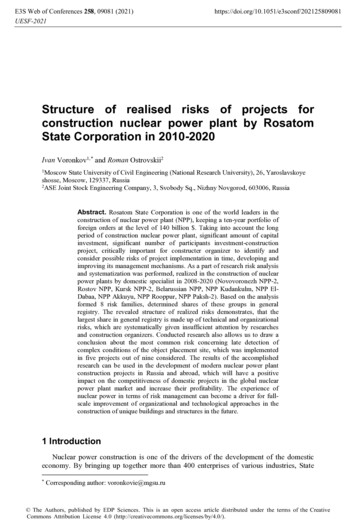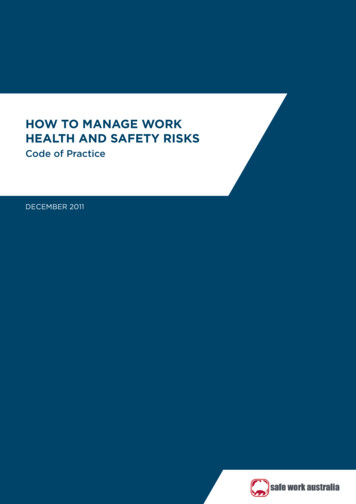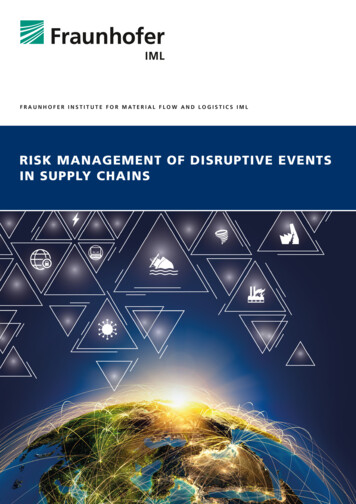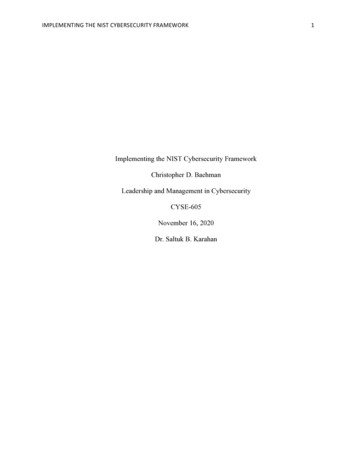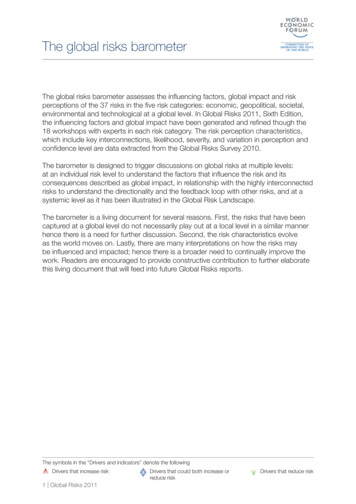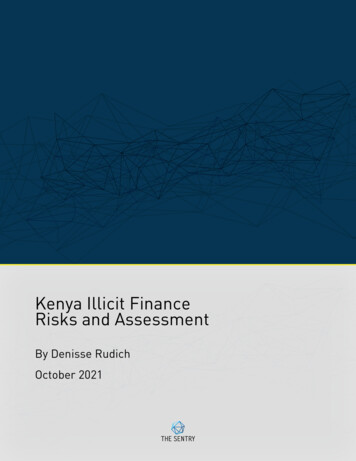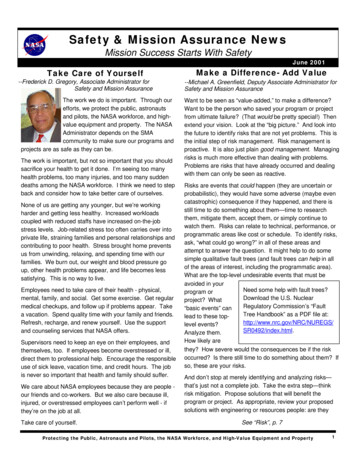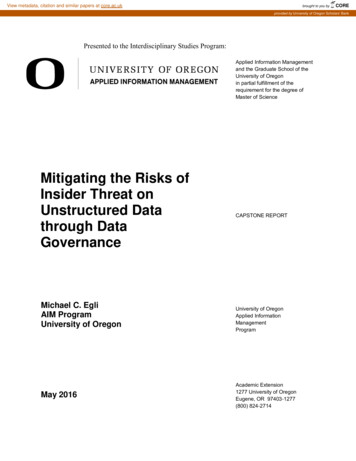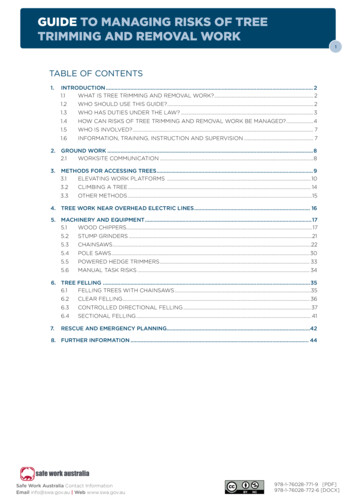
Transcription
GUIDE TO MANAGING RISKS OF TREETRIMMING AND REMOVAL WORK1TABLE OF CONTENTS1.INTRODUCTION. 21.1WHAT IS TREE TRIMMING AND REMOVAL WORK?. 21.2WHO SHOULD USE THIS GUIDE?. 21.3WHO HAS DUTIES UNDER THE LAW?. 31.4HOW CAN RISKS OF TREE TRIMMING AND REMOVAL WORK BE MANAGED?.41.5WHO IS INVOLVED?. 71.6INFORMATION, TRAINING, INSTRUCTION AND SUPERVISION. 72.GROUND WORK. 82.1WORKSITE COMMUNICATION.83.METHODS FOR ACCESSING TREES.93.1ELEVATING WORK PLATFORMS . 103.2CLIMBING A TREE. 143.3OTHER METHODS.154. TREE WORK NEAR OVERHEAD ELECTRIC LINES. 165.MACHINERY AND EQUIPMENT. 175.1WOOD CHIPPERS. 175.2STUMP GRINDERS.215.3CHAINSAWS.225.4POLE SAWS.305.5POWERED HEDGE TRIMMERS. 335.6MANUAL TASK RISKS. 346. TREE FELLING .356.1FELLING TREES WITH CHAINSAWS.357.6.2CLEAR FELLING. 366.3CONTROLLED DIRECTIONAL FELLING.376.4SECTIONAL FELLING. 41RESCUE AND EMERGENCY PLANNING.428. FURTHER INFORMATION. 44Safe Work Australia Contact InformationEmail info@swa.gov.au Web www.swa.gov.au978-1-76028-771-9 [PDF]978-1-76028-772-6 [DOCX]
GUIDE TO MANAGING RISKS OF TREETRIMMING AND REMOVAL WORK21.INTRODUCTIONThis Guide provides information on how to manage risks associated with tree trimming andremoval work.A range of terms are used across the arboriculture industry including lopping, trimming, pruning,thinning, felling and removal. This Guide uses ‘tree trimming’ and ‘removal work’ to cover the rangeof terms used in industry and the Work Health and Safety (WHS) Regulations.1.1What is tree trimming and removal work?Tree trimming and removal work includes lopping, pruning, trimming, repairing, maintaining andremoving amenity trees as well as ground operations relating to tree work like wood chipping,stump grinding and root pruning.Amenity trees are trees with recreational, functional, environmental, ecological, social, health oraesthetic value rather than for production purposes.1.2Who should use this Guide?This Guide assists duty holders including arborists, tree climbers, horticulturalists, gardeners, treeworkers, landscapers, builders, developers and others involved in the amenity tree industry managetheir obligations under the WHS laws.It does not apply to commercial forestry or work done in relation to growing and managing forests.Guidance on forestry and growing and managing forests is in the General guide for managing risksin forestry operations and Guide to growing and managing forests.This Guide is also useful for workers and helps to ensure the health and safety of other people whomay be affected by tree trimming and removal work including members of the public.More specific information on the requirements to manage the risks from falls, machinery and otherhazards associated with tree trimming and removal work like noise and hazardous manual tasks isavailable on the Safe Work Australia website.JULY 2016
GUIDE TO MANAGING RISKS OF TREETRIMMING AND REMOVAL WORK31.3Who has duties under the law?Everyone in the workplace has a work health and safety duty. The main duties are set out in Table 1.Table 1 Duty holders and their obligationsWhoDutiesA personconductinga business orundertakingA person conducting a business or undertaking (PCBU) must ensure, so faras is reasonably practicable, that workers and other people are not exposedto health and safety risks arising from the business or undertaking.For tree trimming and removal work this includes ensuring, so far as isreasonably practicable, the: provision and maintenance of safe plant safe use, handling, storage and transport of plant provision of an emergency plan provision and maintenance of safe systems of work, and where a fall-arrest harness is used, provision and testing of emergencyprocedures including rescue procedures.A PCBU who has management or control of a workplace must ensure, so faras is reasonably practicable, the means of entering and exiting the workplaceand anything arising from the workplace is without risks to health and safety.A PCBU involved in the management or control of plant at a workplace hasa duty to ensure, so far as is reasonably practicable, the plant is without riskto the health and safety of any person.Designers,manufacturers,importers andsuppliersDesigners, manufacturers, importers, and suppliers of plant includingmachinery likely to be used in tree trimming or removal work must ensure, sofar as is reasonably practicable, the plant is without risks to health and safety.This duty includes carrying out testing and analysis as well as providingspecific information about the plant.OfficersOfficers, such as company directors, have a duty to exercise due diligenceto ensure the business or undertaking complies with the WHS Act andRegulations. This includes taking reasonable steps to ensure the business orundertaking has and uses appropriate resources and processes to eliminateor minimise risks including those from tree trimming and removal work andplant used at the workplace.Workers andothersWorkers and other people at the workplace must take reasonable care fortheir own health and safety, co-operate with reasonable policies, proceduresand instructions and not adversely affect other people’s health and safety.JULY 2016
GUIDE TO MANAGING RISKS OF TREETRIMMING AND REMOVAL WORK41.4How can risks of tree trimming and removal workbe managed?The following steps should be used to decide what is reasonably practicable to ensure workers andother people are not injured when carrying out tree trimming and removal work.1.Find out what could cause harm. The following can help identify potential hazards: Observe the workplace to identify how work will be carried out. Consider the physical workenvironment; equipment; materials and substances used; work tasks and how they areperformed; and work design and management. Hazards associated with tree trimming andremoval work can include: tree hazards—see Visual tree assessment being struck by vehicles or mobile plant moving on or working near the work siteslips, trips and fallsmanual tasks i.e. lifting, pushing, pulling, repetitive movements, holding machinerycontact with energised overhead electric lines or underground servicescrush injuries, entanglement, cuts and abrasions from the incorrect use or lack ofmaintenance of machinery e.g. chainsaws, wood chippers and stump grindersfalling objectspunctures and cuts from tree branchesallergic reactions to trees and poisonous plants, andbiting or stinging hazards including ants, bees, wasps and snakes. Ask workers about problems they have found at the workplace. Discuss the risks in carrying out tree trimming and removal work with the operators of cranes orother machinery you may be using at the site. Talk to manufacturers, industry associations, suppliers and health and safety specialists andreview incident and injury records including near misses.Visual tree assessmentThe integrity of a tree is critical to the safety of those working in, under and around it. Beforeworking on or accessing a tree by any method, a thorough visual assessment of the tree shouldbe carried out by a competent person. The assessment should consider hazards, condition, windloading, structural integrity and location. This assessment should form the basis of a site-specific riskassessment and decision-making on whether the tree is safe to access, the method chosen to accessthe tree and the safe systems of work to be used on the site.Figure 1 shows many of the conditions which could result in serious risk if they are not identifiedprior to starting work.JULY 2016
GUIDE TO MANAGING RISKS OF TREETRIMMING AND REMOVAL WORK5Figure 1 Tree hazards2. Assess the risk. In many cases the risks and related control measures will be well known. Inother cases you may need to carry out a risk assessment to identify the likelihood of somebodybeing harmed by the hazard and how serious the harm could be. A risk assessment can help youdetermine what action you should take to control the risk and how urgently the action needs tobe taken.When carrying out a risk assessment think about: The stability and integrity of the tree: Is the tree decayed or dead and unsafe to climb or be attached to?Is the species or the particular tree susceptible to branch failure when under load?Is the tree stable in the ground?Is the crown of the tree leaning heavily in one direction?Is the tree suitable to be climbed? Ensure that no person, plant or thing will come within an unsafe distance of an overhead electric line. Ground surface condition including type of soil, underground services, underground tanks, leachdrains and gradients of ground surface. Maintenance of plant and equipment. Access by people and management of traffic. Animal and insect management e.g. are there insects or other animals in the tree that may be arisk to a worker? Workers being trained including in emergency procedures, working near overhead orunderground services, use of equipment, work tasks and on-site communication.JULY 2016
GUIDE TO MANAGING RISKS OF TREETRIMMING AND REMOVAL WORK6 Action plans about hazards and the nature of the work including number of workers, eachworker’s role and job process after discussion with workers. Weather conditions including heat, humidity and wind speed are suitable to start the job and aremonitored to ensure they are suitable to continue working. Common hazards like vines, creepers in crown, nails and wire are identified and removed orcontrolled. Personal protective equipment (PPE) is fit for purpose and, where appropriate, in accordancewith the relevant Australian Standard. Establishment of exclusion zones.3. Take action to control the risk. The WHS laws require a business or undertaking to do all that isreasonably practicable to eliminate or minimise risks.The ways of controlling risks are ranked from the highest level of protection and reliability to thelowest. This ranking is known as the hierarchy of risk control. You must work through this hierarchyto manage risks.The first thing to consider is whether hazards can be completely removed from the workplace.For example, carry out the work from the ground as this eliminates the risk of falls and issues withtree integrity.If it is not reasonably practicable to completely eliminate the risk then consider the following optionsin the order they appear below to minimise risks, so far as is reasonably practicable: Substitute the hazard for something safer e.g. redesign the work process so less hazardousequipment, materials or quantities are used; use plant specifically designed to lift a person likean elevating work platform (EWP) to gain access to the tree rather than climbing the tree. Isolate the hazard from people e.g. set up a restricted work area; minimise emissions and noisefrom machinery through venting and containment or isolation barriers. Use engineering controls e.g. a boom-mounted pruner.If after implementing the above control measures a risk still remains, consider the following controlsin the order below to minimise the remaining risk, so far as is reasonably practicable: Use administrative controls e.g. rotate jobs and vary tasks to minimise the risks associated withrepetitive manual handling tasks; provide safety information, training and instruction; use writtensafe work procedures. Use PPE e.g. safety eyewear, face shields, hearing protection, safety helmets, boots, cut-resistantleg protection and reflective, high-visibility clothing.A combination of the controls set out above may be used if a single control is not enough tominimise the risks.Consider all possible control measures and make decisions about those controls which arereasonably practicable for the workplace. Deciding what is reasonably practicable includes theavailability and suitability of control measures, with a preference for using substitution, isolation orengineering controls to minimise risks before using administrative controls or PPE. Cost may also berelevant, but only consider this after all other factors have been taken into account.4. Check control measures regularly to ensure they remain effective and that the system is workingas planned, taking into consideration any changes in how the work is carried out.JULY 2016
GUIDE TO MANAGING RISKS OF TREETRIMMING AND REMOVAL WORK71.5Who is involved?Workers and their health and safety representatives (if any) must be consulted when deciding howto manage the risks of tree trimming and removal work.If there is more than one business or undertaking involved at the workplace they must also beconsulted to find out who is doing what. The businesses must work together so risks are eliminatedor minimised, so far as is reasonably practicable.This may involve discussing site-specific requirements, for example the location, maintenance andmonitoring of exclusion zones, pedestrian access and traffic management on and around the worksite; and developing job safety plans.1.6Information, training, instruction and supervisionTree trimming and removal of trees—especially large trees—is dangerous work. This work should becarried out by workers appropriately trained and experienced.PCBU’s must ensure workers have the level of training to enable them to perform their designatedtasks safely and competently. Information, training, instruction and supervision given to workersmust take into account the nature of the work carried out by the worker, the associated risksand measures implemented to control the risks. This includes providing relevant site specific orequipment specific training before work starts.Most tasks carried out in tree trimming and removal work are covered by National Units ofCompetency (UoC) developed by the arboriculture industry.There are a number of recognised qualifications available for anyone who wants to work in thearboriculture industry. These qualifications include a Statement of Attainment, Certificate III inArboriculture, a Diploma of Arboriculture and an Advanced Diploma of Horticulture.Training for these national units of competency is available from registered training organisationsthroughout Australia.Further information can be found on the Australian Government’s training website.JULY 2016
GUIDE TO MANAGING RISKS OF TREETRIMMING AND REMOVAL WORK82.GROUND WORKGround work for tree trimming and removal work can involve different work activities. In someinstances the work may need a minimum of two workers carrying out the activity for the safety ofworkers and those passing by. The tasks assigned to each worker should also take into account theworker’s ability to carry out the work.When assessing the risks associated with work tasks, the following should be considered: the worker’s experience their familiarity with the specific task their understanding of the hazards their knowledge of the planned control measures, and their skills and qualifications with the plant and equipment being used.2.1Worksite communicationWorksite communication methods should be agreed before workers start work. The way workerscommunicate will depend on the tasks being carried out, the equipment being used, noiseimplications and the location of workers at the worksite.Methods for communicating at a worksite include using: two-way devices especially if a worker is elevated in a tree or on a temporary work platform hand signals whistles, and mobile telephones.JULY 2016
GUIDE TO MANAGING RISKS OF TREETRIMMING AND REMOVAL WORK93.METHODS FOR ACCESSING TREESTrees can be accessed by using EWPs or climbing.PPE should be used for all access tasks. This can include eye, hearing, hand and leg protection aswell as protective boots and helmet.Clothing should generally be close fitting and of high-visibility. If using a chainsaw in a tree pantsshould be cut-resistant—see AS/NZS 4453.3:1997 Protective clothing for users of hand-heldchainsaws – protective legwear.Workers carrying out above ground work should be qualified for the type of work being done.Before accessing a tree by any method a visual tree assessment should be carried out by acompetent person. The assessment should include the tree’s overall condition and structuralintegrity with consideration given to structural faults like bark inclusions, decay, hollows, growthhabit, species of tree and root plate failure. The assessment should also consider wind loading andthe tree’s location. This information should inform whether the tree is safe to access, the methodto access and attach to the tree, emergency rescue measures along with rigging and removaltechniques. Common hazards and risks of accessing trees are outlined in Table 2 with examplecontrol measures in Table 3.Table 2 Common hazards and risks of accessing trees slipping out of harness not positioned correctly slipping or falling from branches due to failure of anchor points dehydration and fatigue musculoskeletal disorders from awkward positions falling from height due to incorrect use of ropes, knots and devices like descenders being struck by falling objects or a throw bag wildlife related injuries e.g. from wasps, bees, birds, possums falling from an EWP contact with overhead electric linesJULY 2016
GUIDE TO MANAGING RISKS OF TREETRIMMING AND REMOVAL WORK10Table 3 Examples of control measures for accessing trees checking the location of overhead electric lines before starting work—further information is inChapter 4 - Tree work near overhead electric lines conducting a site specific hazard and risk assessment using an EWP using a rope access system establishing and maintaining an exclusion zone having a spotter to maintain the exclusion zone while work is being done in the tree ensuring the harness and climbing spikes fit correctly and are comfortable being attached at all times e.g. to an EWP planning a clear access route checking the tree for bees, wasps or other animals before accessing checking anchor points thoroughly before leaving the ground weighting your climbing system before disconnecting your second point of attachment having an emergency plan including an aerial rescue procedure ensuring traffic control measures are in place within the established exclusion zone whenworking on or above roads3.1Elevating work platformsEWPs specifically designed to lift people should be used to access a tree, where reasonablypracticable. These minimise hazards like dehydration and fatigue from climbing trees and aredesigned as a working platform to prevent the worker falling.If an EWP is being considered to trim or remove a tree the following should be considered: If it is safer to trim or remove the tree from the ground? Are there obstacles, structures like buildings and other trees present at the site posing a risk tohealth and safety or make access impossible using an EWP? Are there underground services present, for example water, gas, telephone, electricity that mayrestrict access or locations to set up temporary platforms? Do overhead electric lines create a risk for a worker because of the EWP’s position? Is the ground level, uneven, sloping, firm or loose and could this lead to the EWP overturning?Unless designed for rough terrain, EWPs should only be used on a solid, firm and level surfacewhere there are no obstacles that may cause uncontrolled movement. Can the EWP safely reach the height necessary to trim or remove the tree? Does the worker need to lean outside the structure of the EWP? Will the cutting or lowering of the limb, branch or section of the tree be impeded by the use ofthe EWP?JULY 2016
GUIDE TO MANAGING RISKS OF TREETRIMMING AND REMOVAL WORK11Types of EWPs commonly used to access trees for trimming and removal work include: trailer mounted EWPs (see Figure 2) self-propelled EWPs with telescoping boom including knuckle boom (see Figure 3), and vehicle mounted EWPs (see Figure 4).Figure 2Trailer mounted EWPFigure 3Self-propelled EWPFigure 4Vehicle mounted EWPScissor lifts are another common type of EWP but their use in tree trimming and removal work islimited because they have a greater risk than a boom-type EWP of being struck or knocked overby falling branches or trunks. This is because their supporting structure is directly underneath theworking platform. Their use is also generally restricted to flat and firm unsealed surfaces. Scissorlift-type EWPs should not be used unless the risk of falling branches or trunks striking the unit canbe eliminated.The correct type of EWP must be selected for the type of work being carried out. When selectingthe type of EWP to be used the following things should be considered: the ground and weather conditions access limitations the type of tree trimming and removal work to be done the height and reach required the number of workers required on the EWP, and the lifting capacity required.EWPs may not be reasonably practicable to use where: a worker cannot get close enough to the tree to trim the tree safely a tree is too large the EWP may impede the cutting or lowering of the limb, branch or section of tree the ground is sloping or unstable, or there are buildings or other infrastructure in the way.JULY 2016
GUIDE TO MANAGING RISKS OF TREETRIMMING AND REMOVAL WORK12Common hazards and risks of using an EWP are outlined in Table 4.Table 4 Common hazards and risks of using an EWP for tree trimming and removal work coming in contact with overhead electric lines and adjacent structures windy conditions falls from height unstable, sloping, uneven or soft ground e.g. recently filled excavations that could lead theEWP to overturn being struck by falling objects wildlife related injuries e.g. from wasps, bees, birds, possumsOperators of EWPs should be assessed as competent against the relevant national UoC. As differenttypes of EWP require different competencies to operate, training in the specific type of EWP beingconsidered for the work should be provided.Note: The use of a boom-type EWP with a boom length of 11 metres or more requires the operatorto hold an EWP high risk work licence.The operating crew should consist of at least two workers, with one to remain on the ground as asafety observer or spotter. The nominated ground worker should also be trained in the operation ofthe lower vehicle-mounted controls to lower the platform in an emergency.A copy of the operator’s manual should be kept with every EWP. Operators should read the manualand be familiar with it before operating the machine. EWPs should be operated according to themanufacturer’s instructions.A pre-start safety check should be carried out on the EWP in accordance with the manufacturer’sinstructions to identify damaged or faulty equipment and to ensure the EWP is safe to operate. Thesafety check should also ensure the emergency descent is functioning correctly.The EWP operator and safety observer should establish an exclusion zone prior to workcommencing to ensure pedestrians and others are not entering the danger zone.An appropriately trained safety observer or spotter should be in place to monitor clearancesbetween the operating EWP and overhead electric lines, traffic, adjacent structures or other hazards.The safety observer should have a means of communicating with the EWP operator at all times.The safety observer function should be a designated role. They should not be distracted by carryingout other tasks or duties while the EWP is being used.In addition to the above, Table 5 outlines control measures that should be considered when usingEWPs for tree trimming and removal work.JULY 2016
GUIDE TO MANAGING RISKS OF TREETRIMMING AND REMOVAL WORK13Table 5 Examples of control measures for using an EWP for tree trimmingControl measures for EWP use include: Ensuring every person in the EWP wears a full body fall-arrest harness complying with AS/NZS 1891.1:2007: Industrial fall-arrest systems and devices – Harnesses and ancillary equipment.Harnesses must be attached to the purpose-built anchor points provided on the EWP. Checking the location of overhead electric lines before starting work. If overhead electric linesare present the state or territory Electricity Supply Authority or Electricity Regulator should becontacted to find out the extent of the work zones, approach distances and any specific workrequirements that apply to working in the vicinity of the overhead electric lines. Ensuring the rated capacity of the EWP is not exceeded. The rated capacity includes the weightof the operator, any other person on the platform, tools and branches or other debris. Not operating the EWP on gradients that exceed the manufacturer’s instructions and wherepossible keeping the EWP’s boom on the uphill side of the EWP’s base. Ensuring traffic control measures are in place within the established exclusion zone whenworking on or above roads. All parts of the EWP should remain clear of traffic hazards.Operators should be aware of potential tail or knuckle swing into traffic areas. Not using the EWP when wind speeds exceed the manufacturer’s recommendations. Ensuring tyres are inflated to the correct pressure in accordance with the manufacturer’srecommendations. This is critical for the stability of EWPs when outriggers are not being used.If outriggers are required for stability they should be engaged before the platform is raised. Ensuring ground surface conditions are checked. Soft soil, underground services, tanks, drains andpipes can collapse under the weight of the EWP or outriggers and cause the EWP to tip over.Suggested controls for working from the EWP include: Not positioning the EWP under the branch to be trimmed or removed. The EWP should belocated at or above the level of the cut. Keeping the platform free of debris and tree off cuts. Hand tools carried within the platformshould be secured. Ensuring no fuel is carried in the EWP and refuelling is done on the ground outside the EWPcage or bucket. Not attaching ropes between the EWP and any part of the tree. An EWP is not to be used asa crane. An independent rope should be used to lower offcuts. Wearing PPE e.g. a safety helmet, gloves, eye protection and safety footwear. Chainsawoperators should also wear cut-resistant leg protection and hearing protection. Always keeping harnesses attached to the anchor points within the EWP. If climbing from the EWP into a tree, the climber should wear a harness suitable for treeclimbing and be attached to the tree—having loaded the anchor point—before releasing theanchorage on the EWP.Furt
Tree trimming and removal work includes lopping, pruning, trimming, repairing, maintaining and removing amenity trees as well as ground operations relating to tree work like wood chipping, stump grinding and root pruning. Amenity trees are trees with recreational, functional, environmental, ecological, social, health or
